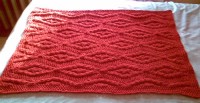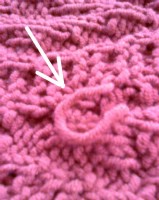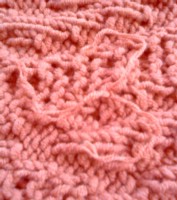PATTERN – RED DIAMONDS BABY BLANKET
UPDATE: THIS PATTERN IS NOW AVAILABLE AS AN EASY TO PRINT PDF AT THE KNITTING PATTERNS LINK, ABOVE.
It’s finished and about to be mailed to the target recipient, so I can post my final pattern for this simple knit/purl texture, quick knit, lap size baby blanket.
RED DIAMONDS BABY BLANKET
Finished dimensions:
About 26.6″ x 36″
Materials:
Approximately 550 yards (about 500 meters) of a lofty wool/acrylic blend super bulky weight yarn, with a native gauge of 12 stitches and 18 rows to four inches. Washable is better.
One US size 10.5 circular needle at least 24 inches long.
Four stitch markers.
Tapestry needle for darning in ends.
Project Gauge:
Just over 2 stitches per inch in stockinette. (Approximate gauge is good enough on a blanket).
Method:
Cast on 77 total stitches but to make life easier when knitting the repeats cast on 5, place marker, cast on 22, place marker, cast on 22 place marker, cast on 23 place marker, cast on 5.
Slip the first stitch purlwise, then continue across the row in K1, P1 seed stitch; knit the last stitch of the row the back of the loop (In seed stitch you make a bumpy texture. If knitting in the flat, you knit every stitch that presents as a purl, and purl every stitch that presents as a knit. If you get ribbing you need to rip out your offending row and begin it again using a knit if you started with a purl or a purl if you started with a knit). Repeat this start-up row 7 times for a total of 8 rows of seed stitch. This will make a nice no-curl lower edge with a neat slip stitch selvedge.
Continuing in seed stitch pattern and making sure to continue the slip stitch selvedge, work seed stitch until you reach marker #1. Then work the white stitches in Row #1 of the following chart. On the final repeat just before the final marker, work the blue stitch in Row #1, then finish with seed stitch, continuing the established pattern of the lower edge.
Flip the work over. Remember that you’re going to be working the wrong side of the blanket and on this row (Row #2 of the chart) and all even side rows thereafter, you need to follow the WRONG SIDE directions for the chart. Again slip that first stitch, work seed to the first marker, now work the blue stitch on the chart (wrong side version), and continue across the chart Row #2. After the last marker finish the row out in seed stitch, knitting the final stitch of the row through the back of the loop.
Click on pix above for a larger version of the chart.)
Continue in this manner until you have worked four full vertical repeats of the chart.
Finish off the blanket with another 8 rows of seed stitch with slip stitch edges, and bind off loosely. Darn in all ends.
NEAT FINISHING FOR SUPER BULKY YARNS
I’ve finished knitting my bulky red baby blanket, and am up to the dreaded “darning in the ends” stage. Now I note that most of the criticism of the now discontinued Kool Wool was laid against its bulk and the number of ends inherent in any short yardage yarn of that weight. There are a lot of ends when you make something – especially a large something – out of a yarn that is only 60 yards per skien; and bulky yarn when darned in can look like large, creepy, and dreadfully obvious caterpillars crawling on the knitting’s surface.
While I can’t do anything about the sheer number of ends, I can make the darning in way less obvious. This fix works for any yarn that is made up of two or more constituent plies. It won’t work for a single.
Here you see my target end. Because this baby blanket will be seen from both sides, it really doesn’t have a front and back. Therefore for each end pair, I threaded one end to each side – at each new yarn ball join point one strand peeks out on the front, and the other peeks out on the back:
You can see my yarn is a thick, noodly cable style strand. Here I’ve separated the six plies into three two-ply bunches:
Why the color is so different in this shot, I haven’t a clue, but I have lousy camera skills. Still, if you squint you can make out that I’ve frayed the end into three sub-units. I then end off each of them individually, burying them in the surrounding stitches for about an inch, then doubling back, still buried to anchor them off; and finally clipping the ends close to the surface.
More bizarre color migration, but you can see the burial idea. And here’s the final result. Ends darned in near invisibly in spite of the yarn weight:
As for the true color of the piece, it’s “none of the above.” It’s more like this. Finished object pix tomorrow, I promise. Then it’s box and mail to the target baby, who by the time the package arrives, should be here too.
FASTER THAN LIGHT
I have to admit that I detest knitting at large gauges. The heaviest yarn I enjoy using is worsted weight (true worsted at 5 spi), beyond that I find that I tire faster and tired fingers = uneven stitches. Still, for all of that I also have to admit that stuff knit at huge gauges goes incredibly quickly. I only get to knit about an hour each evening, and can knock out an entire skein’s worth of progress in that short time:
It’s a good thing that this yarn is inexpensive – doubly so for me because I got it dirt cheap at an odd lot retailer. Knitting would be a very expensive hobby if I favored working at this gauge with good materials.
Chalk up another benefit for lace knitting. It’s got the most cost effective bang-for-the-buck. Twenty dollars worth of lace yarn can keep me amused for a couple of months. Twenty dollars of bulky weight might make a hat and a half and be totally consumed in one night.
MILE A MINUTE PROGRESS
Red blanket continues to grow. As I expected, quite quickly. Here’s two evening’s progress – approximately four 60 yard skeins, and about one and three quarters of the 40 row repeat. I’ve got lots more, and will have more than enough to finish.
This is the front.
This is just a three repeats wide of a simple knit/purl pattern, an extremely easy big bang-for-buck texture well within the beginning knitter’s toolset. The back is slightly different, but also of passable appearance:
Colors on both of the above are a bit skew – the thing is a really vivid tomato red. (The new in-phone camera is a marked improvement over the old one in terms of sharpness, but it doesn’t have an effective flash.)
RACE TO THE FINISH
As mentioned earlier, I have the joy of increased familial demand for baby blankets. In fact, I just found out about a cousin who is expecting a baby within the month. So what’s to do? Go stash-diving to find a good candidate yarn, preferably in a quick-to-knit gauge, then knit it up for expedited shipment.
In this case the best candidate quick-knit yarn to hand is a bag of Lion Brand Kool Wool in a vivid tomato red. This discontinued yarn has been stashed for a couple of years, ever since I found it for a song at a local odd-lot retailer. It’s a superbulky, super soft, noodly 50% acrylic/50% merino wool yarn – marked at 12 st and 18 rows to 4 inches on US 10.5 (6.5mm) needles. The texture ensures that I will need to be creative when end darning happens. I’ll probably have to separate the yarn’s many plies and bury them in different directions in order to avoid inconveniently ugly joins.
Why red? I happen to like bright colors for babies. Regardless of ethnic origin, babies are such pallid, helpless creatures to begin with, giving them a jewel like surround seems warranted. But I am violating a core precept – this yarn is marked as hand wash in cool water. I generally avoid hand-wash yarns for baby gifts, but the 50% acrylic content makes me want to risk it. One sign that shrinking/fulling will be less of an issue – I can’t spit-splice this yarn. I will be washing this prior to giving it to the recipient, just to make sure that the red stays where it’s supposed to and there are no other laundry surprises.
Now what to make…
I happen to like lacy patterns. At first I thought about doing a simple lace panel in the yarn’s big gauge. Some quick experimentation showed that decreases in this pudgy yarn are clumpy looking and unattractive. The knit togethers used in modular knitting also rule out simple directionals. Then I thought of doing something center-out, like a big medallion or swirl. Ditto. It’s just too bulky to show fancy patterning to any good advantage. Rather than continuing to fight the materials, I’ve opted to take advantage of what this yarn does do well – simple knit/purl, and work up a heavily embossed knit/purl repeat, edged with moss stitch. After some noodling around, I’ve picked the Elongated Diamond Pattern from B. Walker’s first Treasury (p.35).
As I experiment with this pattern I encounter the prose direction challenge. I know that lots of knitters prefer their directions to be written out rather than charted. Visually impaired knitters have good reason to want this because charts can’t be voice recorded easily, or fed into computer based reading assist programs. And some of us are wired differently – charts can be confusing if you’re not visually attuned to them, there’s no shame in that. But I’m firmly in the charts-good camp, and find prose directions mind numbingly frustrating. So the first thing to do was to graph up the Walker pattern:
Once graphed, the basic logic of the pattern becomes easy to see. The duplicate column of stitches at the end (or beginning) of each row is easy to spot, as is the stepwise movement of garter stripes around diamonds formed by knit stitches on a purl stitch background.
I’ve cast on three repeats plus 4 stitches of moss border and an edge stitch on either side:
Repeats Edge
((3*22)+1) + 2(4+1)) = 77 stitches
And worked 6 rows of K1, P1 moss stitch. This being an odd number of stitches, each of my full width moss rows begins with a K1. Here are the larval beginnings of the project, on circular #11s, which I chose to increase softness and drape.
We’ll see how happy I am with it as the project as it grows. With luck, it will quite quickly because it will be a race to see which is hatched first: target baby or her blanket.










